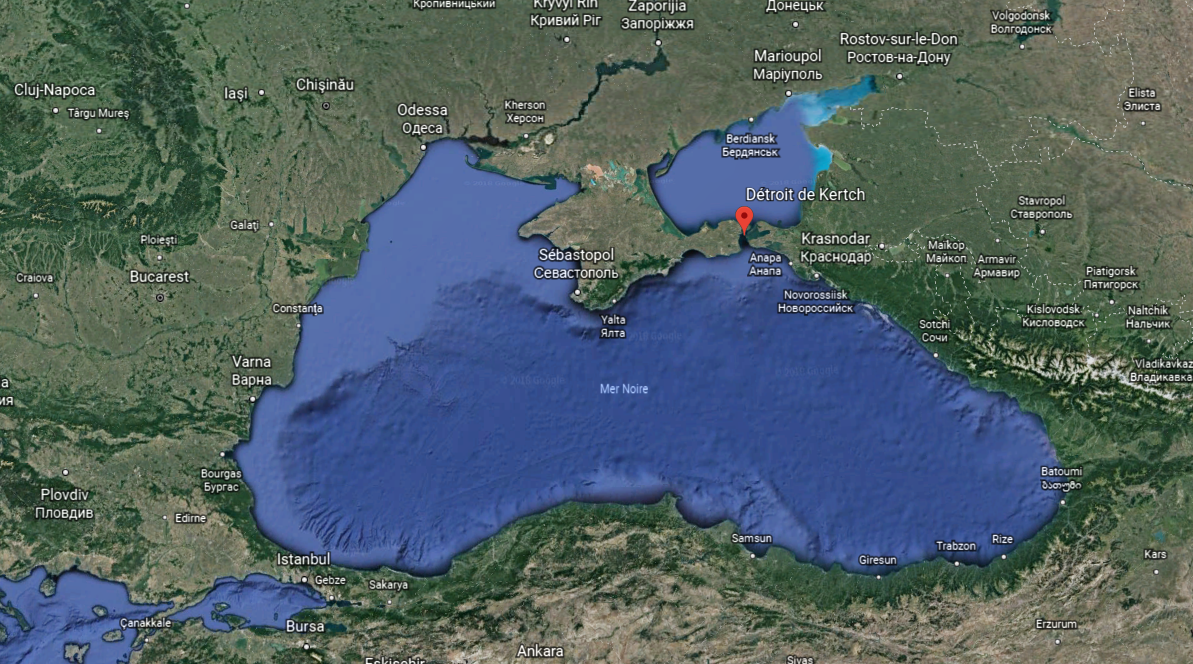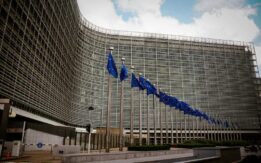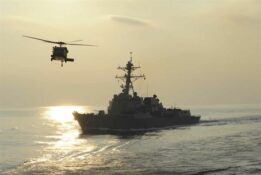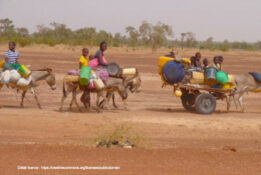Cet article met en exergue la militarisation croissante en mer d’Azov. Son analyse s’appuie sur une mise en perspective historique pour mieux éclairer les enjeux et défis posés par les opérations navales russes qui se développent au sein de cette quasi-enclave maritime, au cœur d’une région en tension entre Russie et Ukraine.
Les opinions exprimées dans cet article n’engagent pas le CSFRS.
Les références originales de ce texte sont : Andrew Wilson, Strait to War? Russia and Ukraine clash in the Sea of Azov, ECFR.
Vous pourrez retrouver l’étude en suivant ce lien
Ce texte, ainsi que d’autres publications peuvent être visionnés sur le site de l’ECFR :
New Russian naval activities around Crimea could presage a new, maritime front in the war in eastern Ukraine
As the new United Nations General Assembly opens, the world should rapidly turn its attention to the Sea of Azov. The Sea of where? Azov may be little known, but this sizeable north-eastern offshoot of the Black Sea – encircled by Russia, occupied Crimea, and Ukraine – could soon be the new frontline in the ongoing war in eastern Ukraine.
The Sea of Azov plays host to the key Donbas ports of Mariupol and Berdiansk. Mariupol itself is indeed known across the world: Russian-backed forces seized it in bitter fighting in 2014, but later relinquished it. Mariupol has since become a symbol of Ukrainian resistance. But Russia is now increasingly militarising the Sea of Azov in a series of moves that could have implications not only for maritime trade and supplies into Ukraine, but also for the ongoing land war in eastern Ukraine. The UN may soon need to take steps to stabilise the region.
How did we get here?
Russia began asserting itself in Azov in 2015 when it began the construction of a long-anticipated bridge across the Kerch Strait. The bridge stretches from Russia to sovereign Ukrainian territory (eastern Crimea), helping yet more arms, men, and equipment move into Crimea. But Russia also designed the bridge in such a way as to reduce the flow of north-south shipping into and out of Mariupol and Berdiansk. The Kerch bridge is just 33 metres in height, making it impossible for larger ships to pass fully loaded. The strait itself is narrow; even before this, vessels would often have to wait before proceeding through.
Things began moving rapidly over the summer and early autumn. In May, Russian vessels in the Sea of Azov began stopping and delaying shipping, including both Ukrainian vessels and those with flags of third party states, imposing huge waiting costs on all vessels on their way to or from Ukrainian ports. On 17 September Ukraine decided to abrogate the general ‘Friendship Treaty’ that it signed with Russia in 1997. But this also leaves it potentially more exposed: the Friendship Treaty contained a promise for both sides to respect each other’s borders and territorial integrity – even if Russia has since broken this promise.
This is an increasingly volatile situation that could spark a new front in the war between Russia and Ukraine. At the end of August, Ukraine announced the “transfer of additional forces of the Marine Corps and coastal artillery” to Azov. In total, Ukraine has sent 270 special forces personnel to the Azov and Black Seas. There is also talk of a possible new Ukrainian naval base in the region. On 23 September, Ukraine caught Russia, for once, unawares, and sailed two navy vessels through the Kerch Strait into the Sea of Azov – a tugboat and the search-and-rescue ship Donbas – which then headed for Mariupol.
The status of the sea is subject to several agreements and live legal claims. In 2003 Ukraine and Russia decided to treat Azov as the “historical internal waters” of both Ukraine and Russia, and to leave the waters undemarcated. Some Ukrainian nationalists are now calling for Ukraine to repudiate the 2003 agreement and make a claim over Azov coastal waters of 12 nautical miles under international maritime law. But this might cede the majority of the sea to Russia and leave Ukraine without access through the strait, as it is unlikely to be unable to enforce a 12-mile claim off Crimea. Ukraine also launched a general UNCLOS case (the UN Convention on the Law of the Sea) against Russia in 2016, that claims that Russia has interfered with Ukraine’s “rights as the coastal state in maritime zones adjacent to Crimea in the Black Sea, Sea of Azov, and Kerch Strait”.
The 2003 agreement provides a right to conduct random inspections, but that was never supposed to lead to a general inspection regime, or be the preserve of one country only. Moreover, vessels sailing to or from Russian ports or Rostov-on-Don do not find themselves stopped. Time delays impose considerable financial costs. Turkish vessels are suffering particularly, but Romanian and Bulgarian and many other EU-flagged ships are also experiencing long and costly delays. Russia’s aim is to put off international business in the longer term.
There is a political backdrop to this too: Petro Poroshenko is standing for re-election in March 2019 on a national security platform, and is taking a tougher line on Azov. Losing Mariupol to Russia again would be a severe blow to Ukrainian morale, at a time when populist opposition candidates, with media support from Russia, are backing a message of ‘peace’ and ‘compromise’ in the 2019 elections, including the later parliamentary elections in October.
From sea to land
What happens here matters for what happens inside Ukraine. Mariupol is the key to maintaining the imports and exports that serve the heavy industry on both sides of the fighting line in Donbas. Remaining economic connections across the frontline would weaken severely. Mariupol may lose viability as a result of these Russian actions, from the impact of the new bridge to Russia’s ramped-up naval activity.
Russia has redeployed several ships from the Caspian Sea to the Azov Sea (via the Volga and the Don and the canal that links the two), including the corvettes the Grad Sviyazhsk and Velikiy Ustyug. The military threats are many: Russian ships could bombard Ukrainian positions from offshore; they could use long-range Kalibr missiles to strike more or less anywhere within Ukraine; either an amphibious landing or the recent expansion of Russian air-drop facilities could insert troops near or behind the current frontline. It is further possible that Russia may be treating this new operation as a dry run for blockading Ukraine’s other ports, west of Crimea. Most of Ukraine’s exports leave by sea, so a Russian escalation of this approach would be greatly damaging to Ukraine’s economy.
The most dramatic scenario would be an outflanking operation that surrounded the Ukrainian army in east Ukraine by landing behind it to the west. Ukrainian troops are dug in. Parts of the front are mobile, but some parts resemble the defensive positions of the Western Front in the first world war. The Russian maritime threat will force Ukrainian forces to diversify and be more cautious about committing soldiers and resources to the current frontline. At the very least, Russia is using the Azov operation to pressure Ukraine to loosen its blockade of Crimea, and resume water supplies, but also to promote disillusion and fatigue with a war that is now more than four years old.
Enter the UN?
Actions on the ground appear to have rendered the 2003 agreement effectively obsolete, but diplomatic protest from the West so far has been minimal, despite the serious nature and strategic intent behind Russia’s Azov operation and the increasing number of ships with Western flags affected by it. The rapid deployment of a UN Maritime Peacekeeping Operation mission would defuse the situation and maintain the freedom of maritime movement in the region, and help to avert any further escalation.
As well as ensuring freedom of movement, the mission’s tasks should include monitoring. It should also provide escorts for Ukrainian and other vessels, as well as receive the power to intercept and inspect vessels and to organise incident resolution meetings. A neutral third country with maritime capabilities, such as India, could lead the mission.
Such a mission would require invitations from Ukraine and Russia. Russia may wield its Security Council veto, but it actually has a long-term interest in reducing tensions, given the expensive infrastructure it is building in the region. Turkey would also be key to any passage of ships through the Bosporus. Discussions about a peacekeeping mission on land for Donbas are currently stuck; a maritime operation would help restart the conversation and bring the UN back into the picture.
Par : Andrew Wilson
Source : European Council on Foreign Relations




































